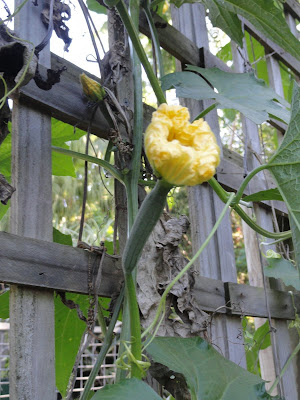You often see loofahs being sold in shops; in Australia they're sold at the Chemist. People see them and know they're sponges but often they're mistaken for sea sponges. Of course there are beautiful sea sponges but loofahs are plant sponges and we grow them in our backyard.
I discovered something new about loofahs this year and last. If you don't pull out the vines when you harvest your summer crop, they'll rest over winter, then start producing flowers and loofahs again the following year. At least they do that here in the subtropics. We planted the loofahs late last year - they went in during November, flowered soon after, produced loofahs in March/April, were harvested in August and we left the vines in. They're flowering again now on very healthy lush vines.
This was taken yesterday. There are about six loofahs growing now.
Loofahs are a member of the vine family of cucurbits, such as pumpkins, squash and zucchini. If you want to grow them, you'll need a warm climate, a large study trellis and about 110 days of warm-hot growing days. They grow well from seeds harvested the previous year so when you pick your loofahs, choose your best ones to collect seeds from.
Loofahs are pollinated by bees but you often see ants on the flowers and vines. They're attracted to the plants and don't usually cause any harm. Plant into rich soil, water in with seaweed tea but don't over-fertilise with nitrogen. A sprinkling of sulphate of potash when planting and another sprinkling when the first flowers appear will keep them producing flowers and fruit. They need to be kept fairly well watered but once the loofahs have grown, you don't want a lot of rain because that will start mould growing in them. The young shoots are suitable for stir frying and the young fruit can be cooked like zucchini but they become hard and fibrous quickly and are then unsuitable for eating but great for washing yourself.
When the flowers turn into fruit and grow, wait until they go brown and start drying out. They can dry out completely on the vine but if you have a prolonged period of rain forecast it's best to pick them brown and not completely dry and leave them in a sheltered position to dry out completely. When the skin is dry and brittle, you can crack them open, shake the seeds out, remove all the outer skin and soak them in a bucket of water to which you've added about quarter a cup of peroxide or a tablespoon of bleach. That will clean them up nicely and kill of any mould spores they might be hiding.
So these are the loofahs we picked in August. They'd been on the vine far too long so some of them were full of mould and had to be thrown on the compost. The rest are fine and will keep us in loofahs for the year.
And these are the vines: above is the vine when I picked the loofahs in August, below is the same vine yesterday afternoon.






